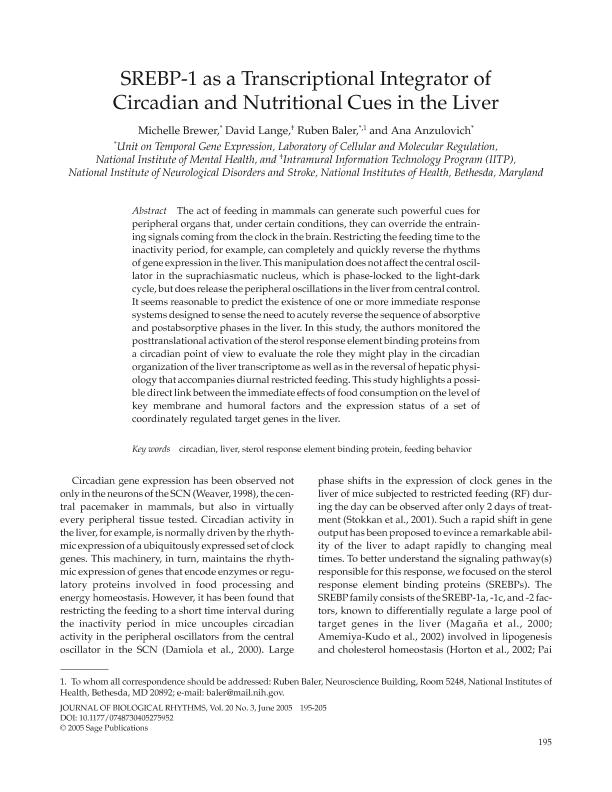Mostrar el registro sencillo del ítem
dc.contributor.author
Brewer, Michelle
dc.contributor.author
Lange, David
dc.contributor.author
Baler, Ruben
dc.contributor.author
Anzulovich Miranda, Ana Cecilia

dc.date.available
2022-06-14T20:08:13Z
dc.date.issued
2005-06
dc.identifier.citation
Brewer, Michelle; Lange, David; Baler, Ruben; Anzulovich Miranda, Ana Cecilia; SREBP-1 as a transcriptional integrator of circadian and nutritional cues in the liver; SAGE Publications; Journal of Biological Rhythms; 20; 3; 6-2005; 195-205
dc.identifier.issn
0748-7304
dc.identifier.uri
http://hdl.handle.net/11336/159739
dc.description.abstract
The act of feeding in mammals can generate such powerful cues for peripheral organs that, under certain conditions, they can override the entraining signals coming from the clock in the brain. Restricting the feeding time to the inactivity period, for example, can completely and quickly reverse the rhythms of gene expression in the liver. This manipulation does not affect the central oscillator in the suprachiasmatic nucleus, which is phase-locked to the light-dark cycle, but does release the peripheral oscillations in the liver from central control. It seems reasonable to predict the existence of one or more immediate response systems designed to sense the need to acutely reverse the sequence of absorptive and postabsorptive phases in the liver. In this study, the authors monitored the posttranslational activation of the sterol response element binding proteins from a circadian point of view to evaluate the role they might play in the circadian organization of the liver transcriptome as well as in the reversal of hepatic physiology that accompanies diurnal restricted feeding. This study highlights a possible direct link between the immediate effects of food consumption on the level of key membrane and humoral factors and the expression status of a set of coordinately regulated target genes in the liver.
dc.format
application/pdf
dc.language.iso
eng
dc.publisher
SAGE Publications

dc.rights
info:eu-repo/semantics/openAccess
dc.rights.uri
https://creativecommons.org/licenses/by-nc-sa/2.5/ar/
dc.subject
CIRCADIAN
dc.subject
FEEDING BEHAVIOR
dc.subject
LIVER
dc.subject
STEROL RESPONSE ELEMENT BINDING PROTEIN
dc.subject.classification
Biología Celular, Microbiología

dc.subject.classification
Ciencias Biológicas

dc.subject.classification
CIENCIAS NATURALES Y EXACTAS

dc.title
SREBP-1 as a transcriptional integrator of circadian and nutritional cues in the liver
dc.type
info:eu-repo/semantics/article
dc.type
info:ar-repo/semantics/artículo
dc.type
info:eu-repo/semantics/publishedVersion
dc.date.updated
2022-06-09T13:36:04Z
dc.journal.volume
20
dc.journal.number
3
dc.journal.pagination
195-205
dc.journal.pais
Estados Unidos

dc.journal.ciudad
California
dc.description.fil
Fil: Brewer, Michelle. National Institute of Mental Health. Laboratory of Cellular and Molecular Regulation. Unit on Temporal Gene Expression; Estados Unidos
dc.description.fil
Fil: Lange, David. National Institutes of Health; Estados Unidos
dc.description.fil
Fil: Baler, Ruben. National Institute of Mental Health. Laboratory of Cellular and Molecular Regulation. Unit on Temporal Gene Expression; Estados Unidos
dc.description.fil
Fil: Anzulovich Miranda, Ana Cecilia. Consejo Nacional de Investigaciones Científicas y Técnicas. Centro Científico Tecnológico Conicet - San Luis; Argentina. Universidad Nacional de San Luis. Facultad de Química, Bioquímica y Farmacia; Argentina. National Institute of Mental Health. Laboratory of Cellular and Molecular Regulation. Unit on Temporal Gene Expression; Estados Unidos
dc.journal.title
Journal of Biological Rhythms

dc.relation.alternativeid
info:eu-repo/semantics/altIdentifier/url/https://journals.sagepub.com/doi/abs/10.1177/0748730405275952
dc.relation.alternativeid
info:eu-repo/semantics/altIdentifier/doi/https://doi.org/10.1177/0748730405275952
Archivos asociados
